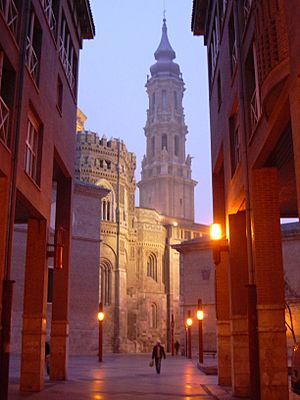Sebastián Aguilera de Heredia facts for kids
Quick facts for kids
Sebastián Aguilera de Heredia
|
|
|---|---|

The Cathedral at La Seo
|
|
| Born | August 15?, 1561 Zaragosa
|
| Died | December 16, 1627 (aged 66) |
| Nationality | Spanish |
| Occupation | Priest, composer, and organist |
Sebastian Aguilera de Heredia (1561-1627) was a Spanish organist and composer. An organist is someone who plays the organ, a large musical instrument. A composer is someone who writes music.
Early Life and Career
Sebastian Aguilera de Heredia was born in Zaragoza, Spain. This happened around August 15, 1561. We do not know much about his early life.
He became a priest in January 1584. In 1585, he started working as an organist at Huesca Cathedral. He even helped with building a new organ there in 1588.
Later, in 1603, he became a priest and organist at the Cathedral of La Seo in Zaragoza. He was in charge of the organ there. He often made sure the organ was fixed and made better. He stayed at this cathedral until he passed away on December 16, 1627.
His Music and Style
All the music Sebastian Aguilera de Heredia wrote was for the church. This included both his organ music and his vocal music, which means music for singers.
His organ pieces show that he learned from older composers like Antonio de Cabezón. But he also added new, modern ideas to his music. These new ideas later influenced younger composers, such as Correa de Arauxo. His students became the organists at the cathedral after he died. They continued his special way of playing for over 100 years.
The Divided Keyboard
One very important new technique he used was the "divided keyboard." This was also called medio registro. It allowed different sounds to come from the top half and the bottom half of the organ keyboard. On organs today, you would need two separate keyboards to get the same effect.
He wrote 36 musical pieces called settings of the Magnificat. These were collected in a book called Canticum Beatissimae Virginis Deiparae Mariae in 1618. His vocal music shows he was very skilled at using polyphony. Polyphony means having many different voices or musical lines singing or playing together at the same time.
References
- The New Grove Dictionary of Music and Musicians, ed. Stanley Sadie; 1980, ISBN: 1-56159-174-2
See also
 In Spanish: Sebastián Aguilera de Heredia para niños
In Spanish: Sebastián Aguilera de Heredia para niños

